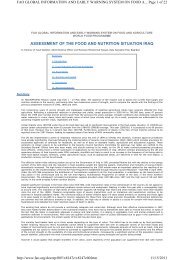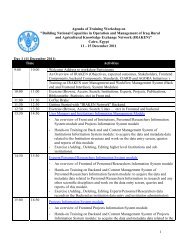Vermiculture in Egypt: - FAO - Regional Office for the Near East and
Vermiculture in Egypt: - FAO - Regional Office for the Near East and
Vermiculture in Egypt: - FAO - Regional Office for the Near East and
Create successful ePaper yourself
Turn your PDF publications into a flip-book with our unique Google optimized e-Paper software.
2.3. The trial experience <strong>in</strong> <strong>Egypt</strong><br />
2.3. 1. Earthworm types used:<br />
Four types of earthworms were brought to <strong>Egypt</strong> from Australia. from Australia:<br />
Lumbriscus Rubellus (Red Worm), Eisenia Fetida (Tiger Worm), Perionyx Excavatus<br />
(Indian Blue), <strong>and</strong> Eudrilus Eugeniae (African Night Crawler).<br />
2.3.2. Bedd<strong>in</strong>g<br />
Two types of vermiculture were used. The first was aim<strong>in</strong>g at <strong>in</strong>creas<strong>in</strong>g <strong>the</strong><br />
population <strong>and</strong> known as breed<strong>in</strong>g vermiculture. The o<strong>the</strong>r type is <strong>the</strong> grow<strong>in</strong>g system<br />
aim<strong>in</strong>g at convert<strong>in</strong>g organic matter <strong>in</strong>to vermicompost.<br />
Commercially available per<strong>for</strong>ated plastic conta<strong>in</strong>ers, generally used <strong>for</strong> harvest<strong>in</strong>g<br />
fruits <strong>and</strong> vegetables, each has <strong>the</strong> dimensions of 30cm wide, 50cm long <strong>and</strong> 20cm<br />
height were used <strong>for</strong> <strong>the</strong> breed<strong>in</strong>g system. The first 5cm from <strong>the</strong> bottom was l<strong>in</strong>ed by<br />
a mixture of 2/3 shredded cardboard <strong>and</strong> 1/3 shredded newspaper, as bedd<strong>in</strong>g<br />
material. The cardboard <strong>and</strong> newspaper were wetted <strong>in</strong> a bucket of water; <strong>and</strong><br />
allow<strong>in</strong>g <strong>the</strong> excess water to run out be<strong>for</strong>e us<strong>in</strong>g. The next layer was 5cm of pH<br />
neutral cast<strong>in</strong>gs spread evenly, <strong>the</strong>n 1-2kg/m² of adult worms was supplied. Every 1-2<br />
days, 1-2kg of old manure was added. The surface was covered by 5cm shredded<br />
newspaper to keep moisture.<br />
The grow<strong>in</strong>g system was made of brick, with <strong>the</strong> dimensions 1m width, 0.5m height,<br />
<strong>and</strong> 3m long, <strong>and</strong> 0.5m between beds. The bottom of <strong>the</strong> beds was <strong>in</strong>sulated by 20cm<br />
cement layer with a slight slope <strong>in</strong> order to facilitate collection of leachate (Photo<br />
2.7).<br />
The sequence of layers <strong>for</strong> <strong>the</strong> grow<strong>in</strong>g beds was <strong>the</strong> same as <strong>the</strong> breed<strong>in</strong>g system<br />
except that <strong>the</strong> base of <strong>the</strong> bed was 10cm of cardboard/newspaper moist mixture, <strong>and</strong><br />
<strong>the</strong> worms spread over <strong>the</strong> surface were <strong>the</strong> juvenile worms only.<br />
20<br />
Photo 2.6.<br />
Earthworms used <strong>in</strong><br />
<strong>Egypt</strong><br />
Source: Au<strong>the</strong>r





